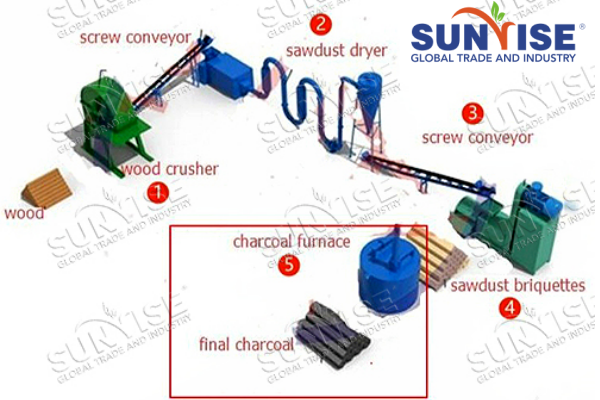Sawdust charcoal, also known as biomass charcoal, is a sustainable and eco-friendly fuel alternative produced from sawdust, a byproduct of the woodworking industry. The process of turning sawdust into charcoal involves several steps, each crucial to ensuring the final product is effective for use as a fuel. This passage delves into the detailed process of making sawdust charcoal, highlighting the methods and machinery involved.

Understanding the Basics: Why Sawdust Charcoal?
Environmental Benefits
Sawdust charcoal is celebrated for its environmental advantages. By using waste material from sawmills and carpentry shops, this process not only reduces waste but also provides a renewable energy source. Charcoal made from sawdust emits fewer pollutants compared to traditional fossil fuels, making it a cleaner alternative for heating and cooking.
Economic Advantages
The production of sawdust charcoal is often less costly than other forms of charcoal due to the abundance of sawdust. This cost-effectiveness makes it an attractive option for both producers and consumers seeking an affordable energy solution.
The Step-by-Step Process of Making Sawdust Charcoal
1. Collection and Drying of Sawdust
The process begins with the collection of sawdust from woodworking sites. It is essential to ensure that the sawdust is dry, as moisture can impede the carbonization process. Drying machines or natural sun drying techniques are employed to reduce the moisture content to below 15%.
2. Compression into Briquettes
Once dried, the sawdust is compressed into briquettes. This step is vital, as it determines the density and burning efficiency of the charcoal. Briquetting machines use high pressure to compress the sawdust into uniform shapes, enhancing the handling and combustion properties of the final product.
3. Carbonization Process
The briquettes are then subjected to the carbonization process, where they are heated in the absence of oxygen to convert them into charcoal. This process can be carried out using traditional kilns or advanced carbonization furnaces. The key is to maintain a controlled environment to ensure complete carbonization while minimizing emissions.
4. Cooling and Collection
After carbonization, the charcoal briquettes are allowed to cool in a controlled setting to prevent them from igniting spontaneously. Proper cooling is crucial to maintain the structural integrity and quality of the charcoal.
Quality Control and Packaging
Ensuring High Standards
Quality control measures are essential throughout the production process to ensure that the end product meets set standards for burning efficiency and emissions. The charcoal is tested for its calorific value, moisture content, and ash levels before packaging.
Packaging for Distribution
Finally, the sawdust charcoal briquettes are packaged in moisture-resistant bags to maintain their quality during storage and transportation. Proper packaging ensures that the charcoal reaches consumers in optimal condition, ready for use in cooking or heating.
Conclusion
The process of making sawdust charcoal is a testament to the innovative use of industrial byproducts to create sustainable energy solutions. By transforming sawdust into a viable fuel source, this method not only addresses waste management issues but also contributes to a cleaner environment. As technology advances, the efficiency and cost-effectiveness of sawdust charcoal production are likely to improve, further cementing its role in the future of renewable energy. Visiting: https://www.ysxcharpro.com/product/sawdust-charcoal-machine-line/
Leave a Reply